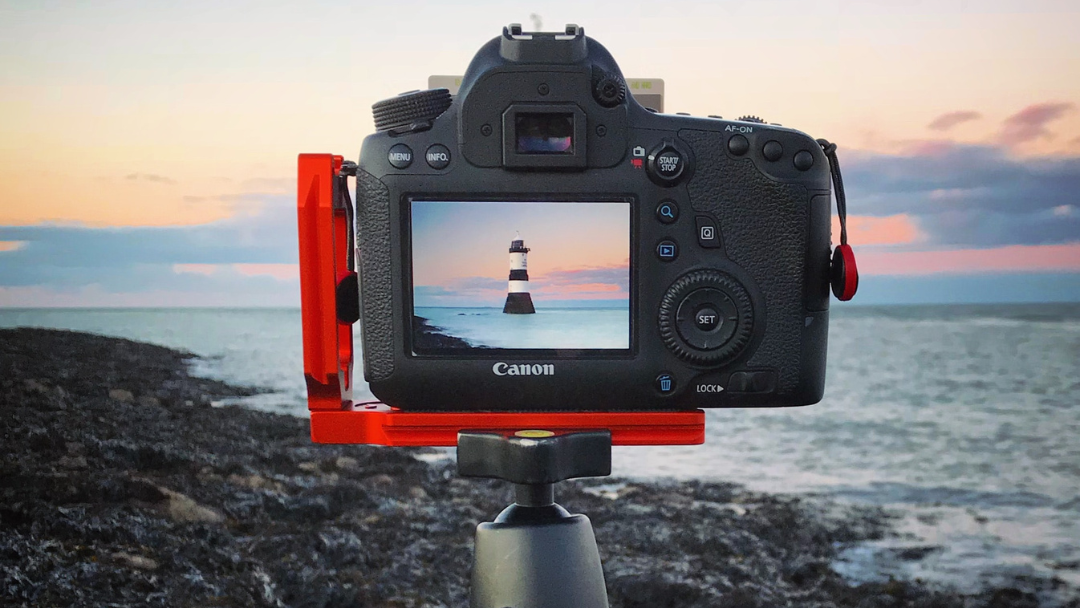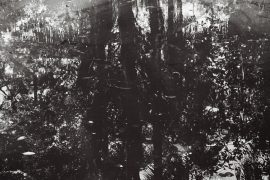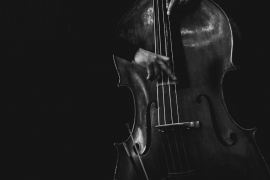FIRST, HIS FACE. Attractive as it is, I add some rosy tones and remove the shadows from under his eyes. The blood-filled, emotive, sympathetic face is in right now. Last year there was a trend toward the pale, mysterious, and vampiric, but as styles come and go, eventually an inverse takes hold. His voice was fine enough, but I added a slight distortion and vocal fry overlay to present him as a little older, a little rougher, a lovely contrast to his boyish and, at some angles, feminine features. To further entice I add some stubble shadow on the edge of his chin and lower jaw to again provide some semblance of weatheredness and subtle masculinity. I ensure that his eyes shine before going to work in the background. I remove cheaper, store bought objects and replace them with higher-end pieces from the marketing list. His wall art was removed in a few clicks and drags and replaced with more minimalist pieces including a Demoix titled, “Blue Desert.”
His joke was fine enough, a little niche, but with a few time edits I perfect his pacing and make it more palatable for most audiences, but specifically the young and sexually active crowd. I replay the clip a few more times before running it through a product simulator. The results in post yielded a high likelihood for advertisement purchases. I sent him three marketing leads, a teaser of the finished product, an invoice, and price chart for future business. I write that I can relinquish the finished product for the agreed upon rate once a negotiation is completed with whatever advertising firm he decides to run with.
After sending this off I get a notification for a post-series of a young woman’s boat day. Her bikini was deplorable and I quickly found her a two piece with a better cut, and a color that matches her precise skin tone, a light azalea pink. I accentuate her belly-button to create what we call, “feature-specific intrigue.” If you’ve ever fallen in love with someone’s hands, maybe the length of the fingers or the texture of the skin, you’ve felt feature-specific intrigue. So I extend her belly-button, giving it both innie and outie qualities. I remove semblances of stubble from her under arm and upper left thigh close to her new bikini line. I reach the second image and do much of the same. I tend to leave her friends relatively untouched remembering to serve the client and the audience. Supporting characters should never be as glamorous as the subject. In a close-up I make her face more inviting, remove upper lip hairs, adjust the eyebrows for a more sarcastic or ornery look, then plump and gloss the lips ever so slightly. The art of it is knowing what the client wants to change without them having to tell you. When you look at a poor beard, or an oddly shaped belly, you might wonder if the wearer of said beard and belly have any desire to change it. Most often they do and your intuition will serve you well as an editor.
Next, a vlog piece. A well spoken woman needs few edits. She is addressing the recent decision in Arizona. I’m not familiar with the debate and the turmoil, and frankly I don’t need to. I go into the time editor and add more well timed pauses and go for a Thresher-like cadence. It’s similar to her speeches during her first run for office, deep eye contact with the camera, and very intentional pauses. I make it a little more idiosyncratic by way of balancing low and high intonations. I changed a few incendiary adjectives, specifically, “cataclysmic,” and, “unstoppable,” to, “problematic,” and, “challenging.” I pull up her blouse, she is speaking to Arizonians after all, and then add a few crows feet. Not too many, but enough to make her look about 35, a sweet spot age we go for when a client has a centrist reputation. I make sure she ends on a smile and edit the handshake with the host to have her appear more authoritative than authoritarian. As I send off the invoice and my remarks I feel a hunger come over me. I put my inbox on do not disturb and decide to take a brief lunch.
I’ve been posting a video series lately called, “Lunch with Las,” wherein, I Silas, make my typical lunch menu items and include the recipes for my followers. Today we are making the Guillotine, a spin off of a French baguette sandwich that I’ve come to love. I set up my tripod, place my phone, and turn on my ring light. Before gathering ingredients I check my face and touch it up with a tinted moisturizer that covers up some minor blemishes. I film myself washing arugula and tomato before carefully using my at home deli-slicer to cut my cheese, meat, and truffle shavings. I assembled the sandwich in short video snippets. I film myself holding the sandwich up to my head displaying its size. I take one big bite on camera, chew a little, then spit out the contents into the compost. I eat sweet potatoes and a kale salad instead, off camera. As I eat I track the posts’ views and am satisfied with around 8k views in five minutes, fairly typical for my lunch series.
As I eat I assess my apartment. I’ve been particularly vexed by my reading nook. Something about it that I haven’t been able to place leaves me confused. The cushioned window ledge serves the room well, and I believe the pillows, specifically the maroon velvet set, were a fine edition. The cream silk curtains allow for a moderate amount of light to pass through which is good for reading. I review the books on the shelf above the nook and am disgusted to find a second edition copy of, “Before the Lightning Strikes.” How could I have let this go unnoticed? Clearly this edition is the green dust jacket, with the rabbit insignia on the spine. The first edition is red, no rabbit. When I had ordered the collection of books I had ensured, via the curator, that all editions would be of the utmost quality. I remove the book and set it on the table. I decided to donate it somewhere. I peer at the spine of every other book to make sure there are no other errors. Then I am confounded by what to do with the space between, “High Road Wanderings,” and Phillip Bagley’s, “On Ferns and Life’s Passings.” I quickly ordered a copy of, “Watchdogs on the Bay,” to fill the gap then remember that this was the writer’s first novel and was only a finalist for the Pacific Review Book Award. I order three other books each having their own merit and leave the decision for the gap for another day.
Panic takes me as I realize that this copy of, “Before Lightning Strikes,” caused a larger error than I’d realized. I open my personal computer and review my recent posts, apartment tours, yoga tutorials, miscellaneous political rants, get-dressed-with-mes, book reviews, anything with the reading nook in the background. I edit them viciously and remove every frame that, “Before the Lightning Strikes,” appeared in, even if the title could not be read. I replaced the error with a small, tasteful, first edition of, “Love and Life in Post-War Canada,” a dystopian fiction novel that is relatively unheard of, but loved by its cultish audience. I breathe deeply, and do an emergency compassion meditation to alleviate the shame and angst from my bookshelf blight. Feeling centered I returned to my work for the afternoon.
In my inbox I find an egregious mess of a task. Seventeen photos of a house for-sale. The photographer, the realtor, whoever, had done me no service. The house was barren, no model furnishings. Both the interior and exterior of the little bungalow were unclean and no charm was achieved through its detritus. The cob-webs on the front porch alone took me thirty minutes to carefully remove. At one point I debated masking them with various hanging-baskets or string-lights, but thought better of it. I did however add a patio set of furniture consisting of a small mahogany table and multiple wicker rocking chairs. It gives a certain rural peacefulness that is enticing to all these days. The foyer? Despicable. Quickly I, “sweep,” the floor and color touch the blemishes of the wall-paint. I imagine the laborers using cheap paint hurriedly on a home that deserved better. I zoom into the hardwood and add a layer of gloss and shine. I repeat this process in every empty room before filling the home with virtual furnishings. For inspiration I peer through the catalogs I have on hand. Sticking with my outdated yet charming aesthetic I morph the place into a comforting farm home. Red checkered towels, an oak-slab table, a barber’s chair for the reading nook, multiple landscape paintings by an artist named Fallanti, whose use of shadow is not to be overlooked even a hundred years later, leather bound books on floor to ceiling shelves, a lovely cast-iron set in the kitchen, when I think I’m done I pause, breathe deeply and inspiration shows me the next edit. I work quickly to respect my clients time, but still spend far too long on what typically is a simple project. I sent an email expressing how difficult this task was and that I expected better from my clients. I charge an additional 15% for the increased labor. I remind them that good edits have good subjects already. I let them know that if my work does not target the appropriate audience I can do a touch up for 5% of the original charge. I rarely do touch-ups because I have the eye at first glance. Once I’ve sent the invoice I have a few minutes of peace where my inbox remains empty.
I climb on to my turn of the century settee and open a first edition, illustrated copy of, “Hella’s Run,” and pick up where I left off. I’ve been laboring through Anne Harding’s first novel for the past three days. I’m not sure what all the rave is about, but as a person of culture I am obligated to finish it and be aware of what’s on the forefront of not only literature, but all mediums. Her characters are flat and the plot is ambiguous. Most anyone can see what thesis she is meandering around, the existential ennui of someone in their mid-thirties looking back on the first portion of their life with disdain, resentment, and confusion. It’s an important aspect of the human experience and general growth as an intellectual, but Harding offers no new insight to this age-old problem. With my favorite annotation pen, a fountain with a delicate nib by Howard and Flitz that I’ve loaded with a cobalt blue ink, I carefully mark a few metaphors that stand out above the murky prose, but mostly scratch out erroneous sentences and words that create a passive voice. Recently, some trend of acceptance has removed the technical aspects of good writing. I laugh to myself thinking that Harding must have done two, three, revisions tops to the whole of the novel. Mentally I start tracking moments where a, “to be,” phrase could simply be restated by concise verbiage. I manage my way through an awkward sex scene that held little to no worth toward character progression. In the margins I write, “could use smuttier similes to denote the relationship between Vickie and Barb.” I smile and gently chide myself for working even when I’m not. As I ponder the possibility of sex as a sub-theme for the novel I hear my desktop chime. With little interest I bookmark the novel with a piece of rose velvet and pace over to my desk.
I’d received a run of the mill basic selfie request. When you first find perfection you may not notice it and it may find you in the most unlikely spaces of artistic expression. It is only by vicious scrutiny that we discover it. Her hair was immaculate, a perfect shade of raven cropped at the shoulder. I tried fourteen different shades and realized that her selection was the right one. It even matched the blackwood accent of her bookshelf. Shoulder line, neck, collarbones, all at perfect angles and ratios. I resized them, adjusted her posture, but found myself returning to her original positioning. Her breasts and belly also needed no edits. Slight protrusions in the blouse marked the placement of her nipples and the shadows of the ribs were mild valleys like sheep pastures. Her jewelry was well crafted, probably by a private jeweler, and matched the skin like gemstones found in a cool creek. I could not find a single hair on her legs. I zoomed in to every inch of her and could find no imperfection. I meticulously scanned each toe, no dry skin, no chipping on her lacquer, no calluses. Her hands were equally divine and posed appropriately for the longing gaze her eyes and body gave. I spent forty-five minutes adjusting the angle of her leg and realized that her positioning of thirty-seven degrees was the correct choice. Thirty-nine gave her a more based look, and thirty-six took away the slight suggestion of power that thirty-seven clearly implied. I felt my heart racing as I left her body alone. I could always come back to it. The background was something I had never encountered. I couldn’t find a single dust-fleck, spare piece of paper, hair-tie, nothing. In a strange sensation of tilt, I sent the image to IT to see if it had already been edited and sent by some mistake, but no, it was the original. I scanned the books on the shelf that she posed in front of. “Harken’s Tales of Grief in San Francisco,” by Remy Charnelton, “Battered Legs,” by Beatrice L. Denoir “See Me, Hear Me, Feel Me,” by Addie Bundran, “Assault on these Lands: A tale of Body and Mind in the Skirmishes of South Dakota,” by Vic Hannold, “The Tree Bark Sings,” by Alexander West, “Unique as the Sand,” by Moody Franklin, “The Moans of the Ocean,” by Yonic Brighton, “Hurry, Hurry, We’re Leaving,” by Luther Bastian, “Polar Bear News: An Anthology,” by various 30’s resistance poets, “Thirty Days in Yasheru,” by Renee Fleur, “The Strength to Fight,” by Betty Donalds, “Werewolf Love Songs: Poems,” by Wesley Gibes, “These Streets are Not Yours,” by Theandra Davies. The editions were perfect, leather bound, dusted, but by the subject’s expression, a viewer could tell they had been read, no, consumed and radically, deeply, understood every word on the shelf. There was not a single title to swap for a superior work. My eyes flitted from her shelf to mine and I felt a strange pain looming in my back. The floorboards? ¾ inch Bellawood. The curtains? A royal blue set by L’amour de Practique Exacte’s decor line. Typically Exacte’s focus was on custom gowns and accessories, but three Springs ago they broke ground into interiors and set a precedent that has not been matched since. The frames on the walls? An immaculately and ornately framed gallery of Rashodd Gadson’s most recent portrait work of the houseless of San Antonio, controversial pieces, but loved nonetheless. Her house plants were real and well maintained as evidenced by the exact shades of leaf color denoted in this years, “Houseplanter’s Almanac.” I returned to her body and felt the pain in my back intensify as I noticed a wisp of hair over her eye, so tasteful, so delicate, that it brings memories of summers on Lake Michigan that I’d never had. I notice a tear pouring down my face. Her entire being was feature-specifc intrigue. I turned off my monitor.
This Mona Lisa, this Girl with a Pearl Earring, this Venus, plagued me. I fibbed a brief response,
Dearest _____,
I thank you for your business. I regret to inform you that our offices are horribly backed up of late. Trust that your fine work is in queue and will be addressed as soon as our staff are available.
Warm regards,
Silas
I ate only greens and drank only water as I continued to pour myself over her photograph. I edited no other requests, and I filmed no posts for my personal accounts. In all my years as an editor-artist, I’d never encountered a predicament such as this. All works can be improved, can’t they? Perfection does not exist. It is my job to ellevate, to transcend. There had to be something. Days went on like this. Hours of trial and error, but her intuition always surpassed my second, and even third, eye. I became disheveled. I neglected my hygiene routine. “Hella’s Run,” went back on the shelf. I drank more Cabernet than my diet allotted. My bones ached and I slept only in brief naps during the day. During intermissions from my work I looked to myself and my home with rage. I removed all the books from my shelves. I listed my furniture on a re-sale site. I put my kitchen towels in a box marked, “free.” I dropped 80% of my wardrobe off at goodwill and received a receipt for a future charitable tax deduction of around 8,000 dollars. I ordered paint, curtains, rugs, and cookware. I dipped into savings and got approved for another credit card. After my demolition I looked around my apartment and felt some relief that I now had a blank canvas to work with. Yes, it was a mess of cardboard and plastic packaging, but at least I knew the vision I was aspiring to.
I looked at the photo again. I examined her hands once more and my mind was flooded with images of Mary’s left hand in Michelangelo’s, “Pieta.” My despair turned into rumination as I wondered how such a still-life could be possible. I wondered if this was some cruel office prank that Anton, or Cherie, had put me on. I remember last year’s prank, the law office advert with the racy Executive. No, Anton and Cherie weren’t capable of this. They couldn’t produce this and hide their edits. I’ve seen their work. Derivative at best. This line of thinking did lead me to a possible solution. I emailed Devon and told her of my predicament. We scheduled a three o’clock virtual.
While waiting for the afternoon to arrive I created a backdrop in my apartment that would be acceptable for the meeting. I moved a houseplant to cover the majority of the book nook, took my remaining painting, a Demoix of my own, and hung it above my television. I re-hung the curtains and left them open to create a sun glare on my camera. I looked from my webcam, to the background and back again. If worse came to worse I could always say I was in the process of remodeling, which wasn’t a lie in the slightest. I laid down. I did nothing. I laid on my aching back and peered into the white paint. When I closed my eyes I saw her hair. When I opened them I saw her ankles. I was truly tortured.
“Hey there dearest, how are you?” came Devon’s voice as the audio initialized.
“In all honesty, I’m floundering. I’m really struggling with what should be a simple edit.”
“Oh, let me see. You never get stumped. This is so unlike you.”
I shared my screen and displayed her and her divinity to Devon.
“Well let’s take a look,” I relinquished host control to Devon and she began to scan the grid of the photo.
“Well you can always look at errors in the threads of her…” She trailed off on a zoomed in portion of her top.
“We can take a peek at the volumes,” Devon listed the titles to herself and became just as lost as I had. I sat in silence and shook my leg as Devon scanned every pixel of the image.
“She didn’t edit it before sending in her work?” she asked.
“No, no, I had it checked. That’s how concerned I was.”
“It’s not possible. This can’t be a live take. Were there other shots? Outtakes or references that she sent with the order?”
“It’s just the one frame, Devon.”
There’s a pause where we both realize that we are helpless.
“I can’t help you.”
Frustrated, I ended the meeting.
That night I got drunk, a misanthropic and disparaging drunk that cured nothing. I paced the house and kicked cardboard boxes around. My hair was horrid, disheveled, and strands were falling onto the unswept floor. I kept all the lights and the tv off. The only glow in the apartment came from my computer screen where she was projecting onto my exhausted eyes. She fills me with nostalgia I’d long forgotten. When I looked at her forearm I remembered the sunburn I got ten years ago tanning with Angelline. The odd itch and burn that her tattooed hands caused on my back when we embraced for the first time. The subject’s mouth and its slightly cynical display vaulted me back to college and the debate on the importance of the artist’s plight that I had with a particularly adversarial professor named, Till. Every feature of her vaulted me into my life’s tenderest moments. Vacation in France with my deepest lover, Angelique, the first time I kissed Richard and felt the freedom of exploration, planting lilacs and hydrangeas with my mother before she died, the first time my work had received critical acclaim after years of scraping by. It overwhelmed me and I felt the pain in my back swell into a cascade of emotion that I’d never felt before. I looked into her eyes and my eyes misted. I stayed like this for some time and never let a tear fall.
It struck me.
I opened the editor and made the slightest of changes to her eyes. I subtly misted them with a reflective sheen. I examined every micro-expression and corner of her eyes and brows and tightened them ever so slightly. A brief, barely perceptible expression of pain was laid like a secret on her face. Very few in the audience would catch it, but for those who did it would sing the muses. I blinked and finally let a tear fall down my face. My job was done.
ALEX ELWELL is an emerging writer from Portland, Oregon. “From the Editor’s Desk,” is his first published work. Alex earned his undergraduate degree in Psychology from Portland State University. He now works in the mental health field as a trainer.
Like what you’re reading?
Get new stories or poetry sent to your inbox. Drop your email below to start >>>
OR grab a print issue
Stories, poems and essays in a beautifully designed magazine you can hold in your hands.
GO TO ISSUESNEW book release
Ghosts Caught on Film by Barrett Bowlin. Order the book of which Dan Chaon calls “is a thrilling first collection that marks a beginning for a major talent.”
GET THE BOOK



